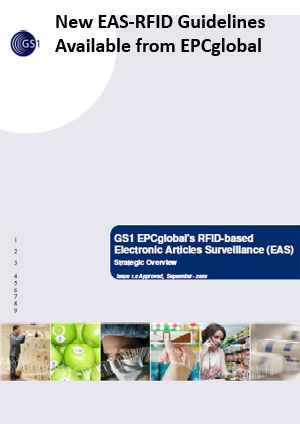Of course, such tags now are generally used on just a subset of overall consumer goods, generally those that are expensive and prone to theft. That includes apparel, consumer electronics, some health and beauty products, entertainment media, etc. Often, retailers in the same basic category take very different approaches to their use of EAS.
Still, the use of an RFID-enabled EAS tag could be a breakthrough, as it would only modestly change an existing process for many manufacturers and retailers, and provide tracking and even shrink management benefits not available from traditional EAS tags. New POS software and readers, of course, would need to be deployed.
How it Would Work
In general, as noted above, existing EAS tags are simple on/off devices. In this new vision, an EPC tag carrying a unique EPC serial number would be attached, either at source or the store, to each item for which such control was desired.
 If source tagged, the tags would be read as new merchandise entered a retail store. It is assumed that the retailer would want to use the RFID tags on the products to improve the speed and accuracy of the receiving process. If source tagged, the tags would be read as new merchandise entered a retail store. It is assumed that the retailer would want to use the RFID tags on the products to improve the speed and accuracy of the receiving process.
The tagged merchandise could also be tracked onto the store floor, to make cycle counts, etc., identical to the traditional vision of RFID at retail.
The main difference is that the backroom receipt would trigger adding the serial number of each item to that store’s “unsold items” database – obviously, a new concept.
When a consumer purchases an item, a tag read at POS would change that EPC serial number's status to “sold” or some similar designation.
So, when a consumer leaves the store, an RFID reader array/portal would query the tags, and verify that all the items have, in fact, been purchased. If a shoplifter tried to leave the store, the store system would recognize that there were one of more “unsold” items being taken out, and sound an alarm similar to current EAS systems.
In addition to providing tracking and EAS in one chip, there are other potential advantages. For example, if a shoplifter simply runs through the EAS portal currently, all that a retailer knows is that goods have been stolen. What products and how many are not known.
In the RFID/EAS vision, store management would know immediately down to the serial number what items and quantities were taken.
Checkpoint Systems and Tyco/ADT, both long-time players in EAS and RFID, are two key technology players in this convergence.
Checkpoint says it has solved one big potential issue, and that is new technology that can focus the reader signal to only pick up tags going through the portal, not tags on products that consumers may have in a cart or in their hands but not yet purchased as they pass near the readers. Too many false alarms like that would likely kill the concept.
“This is a very interesting concept, and one that may have some real legs,” says SCDigest editor Dan Gilmore. “The change is very incremental. Someone is already applying an EAS tag on those products. Just swipe it out for a new, improved RFID version.”
One potential barrier, he notes, are products that have large, re-usable tags that are very hard for potential shoplifters to remove.
“It’s not immediately clear to me how you would make these combined tags difficult to remove by a shoplifter,” he said. “You also might need to be able to re-use these larger tags in someway.”
The Strategy and Technical guidelines are available at no charge on the EPCglobal web site. See: EAS/RFID documents.
What is your perspective on a combined EAS/RFID tag for retail? Could it be an important catalyst in moving RFID adoption forward? Let us know your thoughts at the Feedback button below.
SCDigest is Twittering!
Follow us now at https://twitter.com/scdigest
|